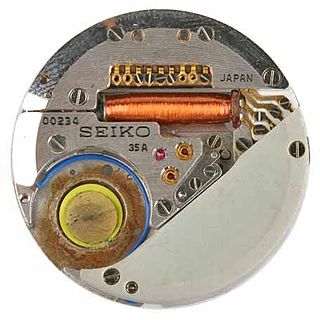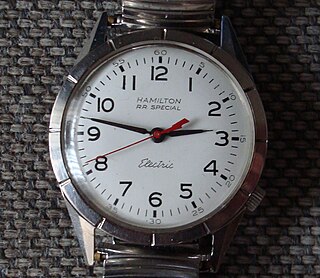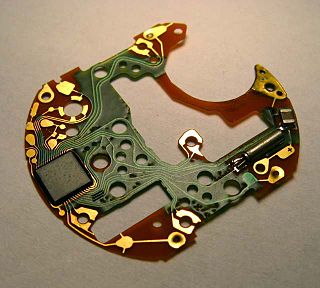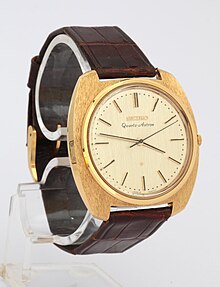
A watch is a timepiece carried or worn by a person. It is designed to keep a consistent movement despite the motions caused by the person's activities. A wristwatch is designed to be worn around the wrist, attached by a watch strap or other type of bracelet, including metal bands or leather straps. A pocket watch is carried in a pocket, often attached to a chain. A stopwatch is a watch that measures intervals of time.

Casio Computer Co., Ltd. is a Japanese multinational electronics manufacturing corporation headquartered in Shibuya, Tokyo, Japan. Its products include calculators, mobile phones, digital cameras, electronic musical instruments, and analogue and digital watches. It was founded in 1946, and in 1957 introduced the first entirely compact electronic calculator. It was an early digital camera innovator, and during the 1980s and 1990s, the company developed numerous affordable home electronic keyboards for musicians along with introducing the first mass-produced digital watches.

Orient is a Japanese watch manufacturer founded in 1950. Established as an independent company in 1950, it became a functional subsidiary of Epson in 2009 before being fully integrated into the company in 2017.

Seiko Group Corporation, commonly known as Seiko, is a Japanese maker of watches, clocks, electronic devices, semiconductors, jewelry, and optical products. Founded in 1881 by Kintarō Hattori in Tokyo, Seiko introduced the world's first commercial quartz wristwatch in 1969.

Seiko Epson Corporation, commonly known as Epson, is a Japanese multinational electronics company and one of the world's largest manufacturers of printers and information- and imaging-related equipment. Headquartered in Suwa, Nagano, Japan, the company has numerous subsidiaries worldwide and manufactures inkjet, dot matrix, thermal and laser printers for consumer, business and industrial use, scanners, laptop and desktop computers, video projectors, watches, point of sale systems, robots and industrial automation equipment, semiconductor devices, crystal oscillators, sensing systems and other associated electronic components.

In horology, a tourbillion or tourbillon is an addition to the mechanics of a watch escapement to increase accuracy. Conceived by the British watchmaker and inventor John Arnold, it was developed by his friend the Swiss-French watchmaker Abraham-Louis Breguet and patented by Breguet on 26 June 1801. In a tourbillon, the escapement and balance wheel are mounted in a rotating cage, with the goal of eliminating errors of poise in the balance giving a uniform weight.
The Hamilton Watch Company is a Swiss manufacturer of wristwatches based in Bienne, Switzerland. Founded in 1892 as an American firm, the Hamilton Watch Company ended American manufacture in 1969, shifting manufacturing operations to the Buren factory in Switzerland. Through a series of mergers and acquisitions, the Hamilton Watch Company eventually became integrated into the Swatch Group, the world's largest watch manufacturing and marketing conglomerate.

The history of watches began in 16th-century Europe, where watches evolved from portable spring-driven clocks, which first appeared in the 15th century.

Automatic quartz is a collective term describing watch movements that combine a self-winding rotor mechanism to generate electricity with a piezoelectric quartz crystal as its timing element. Such movements aim to provide the advantages of quartz without the inconvenience and environmental impact of batteries. Several manufacturers employ this technique.

Seiko Group was a Japanese corporate group consisting of three core companies Seiko Holdings Corp., Seiko Instruments Inc. and Seiko Epson Corp. The three companies were linked by a common thread of timepiece technology. In the present day, the Seiko Group is recognized as a corporate group composed of Seiko Group Corporation and its subsidiaries and affiliates. Although Epson still develops and manufactures wristwatches for the Seiko Group, Epson and its subsidiaries are not considered part of the group.

A chronometer is an extraordinarily accurate mechanical timepiece, with an original focus on the needs of maritime navigation. In Switzerland, timepieces certified by the Contrôle Officiel Suisse des Chronomètres (COSC) may be marked as Certified Chronometer or Officially Certified Chronometer. Outside Switzerland, equivalent bodies, such as the Japan Chronometer Inspection Institute, have in the past certified timepieces to similar standards, although use of the term has not always been strictly controlled.

The quartz crisis (Swiss) or quartz revolution was the advancement in the watchmaking industry caused by the advent of quartz watches in the 1970s and early 1980s, that largely replaced mechanical watches around the world. It caused a significant decline of the Swiss watchmaking industry, which chose to remain focused on traditional mechanical watches, while the majority of the world's watch production shifted to Japanese companies such as Seiko, Citizen and Casio which embraced the new electronic technology. The strategy employed by Swiss makers was to call this revolution a 'crisis' thereby downgrading the advancement from Japanese brands.

In horology, the term electric watch is used for the first generation electrically-powered wristwatches which were first publicly displayed by both Elgin National Watch Company and Lip on March 19, 1952, with working laboratory examples in Chicago and Paris. The Hamilton Watch Company would be the first to produce and retail an electric watch beginning in 1957, before the commercial introduction of the quartz wristwatch in 1969 by Seiko with the Astron. Their timekeeping element was either a traditional balance wheel or a tuning fork, driven electromagnetically by a solenoid powered by a battery. The hands were driven mechanically through a wheel train. They were superseded by quartz watches, which had greater accuracy and durability due to their lower parts count. Recent automatic quartz watches, which combine mechanical technology with quartz timekeeping, are not included in this classification.

Quartz clocks and quartz watches are timepieces that use an electronic oscillator regulated by a quartz crystal to keep time. This crystal oscillator creates a signal with very precise frequency, so that quartz clocks and watches are at least an order of magnitude more accurate than mechanical clocks. Generally, some form of digital logic counts the cycles of this signal and provides a numerical time display, usually in units of hours, minutes, and seconds.

A smartwatch is a portable wearable computer that resembles a wristwatch. Most modern smartwatches are operated via a touchscreen, and rely on mobile apps that run on a connected device in order to provide core functions.
The Tour de I'lle is a complicated wristwatch manufactured by the Swiss manufacturer Vacheron Constantin. It was released in 2005 in a limited edition of 7 pieces to commemorate the manufacturer's 250th anniversary.

The Omega Electroquartz was introduced in 1969 as the first Swiss quartz watch to be produced. It was the collaboration of 20 Swiss watch companies and the movement was utilised by Rolex, Patek Phillipe and Omega amongst others. The Beta 21 movement used in the Electroquartz was accurate to 5 seconds per month, far better than any automatic or manual wind movement of the day.

All Time Best is the 17th compilation album by Japanese entertainer Miho Nakayama. Released through King Records on December 23, 2020 to commemorate Nakayama's 35th anniversary, the three-disc album compiles all 39 of her past singles plus one song from her 2019 album Neuf Neuf. A limited edition release features a bonus Blu-ray disc that includes an HD remaster of Virgin Flight '86: Miho Nakayama First Concert.

Chisato Moritaka Concert Tour '92: Live Rock Alive Complete is a live video by Japanese singer-songwriter Chisato Moritaka. Recorded live at the Nakano Sunplaza in Nakano, Tokyo on September 30, 1992, the video was released on November 23, 2022, by Warner Music Japan to commemorate Moritaka's 35th anniversary. It is a digitally remastered version of the live video originally released on February 25, 1993, with two additional songs and previously unreleased footage. The video is offered on Blu-ray and DVD formats; each with a two-disc audio CD version of the concert. A limited edition Blu-ray boxed set includes a Blu-ray copy of the original 1993 cut, a digitally remastered version of the Rock Alive CD, a photo booklet, a miniature reprint of the original tour pamphlet, a sticker sheet, and a flyer.

The Mitsuoka Rock Star is a retro-styled sports car produced by Mitsuoka between 2018 and 2022. It was announced as a special model to commemorate the 50th anniversary of Mitsuoka. Based on the fourth generation Mazda MX-5, the front and rear exteriors have been changed to resemble the Chevrolet Corvette (C2). The Rock Star is described as "naughty, stylish, and fun", and in contrast to Himiko, which is also based on the MX-5, it features a masculine and wild style.



















